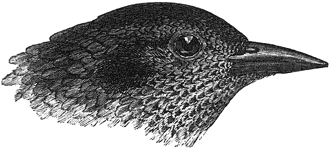| Page 21 | prev page next page | |||
|
Genus MICROPTERNUS, Blyth, 1845 Bill like that of Miglyptes, curved above, without nasal ridge, but the chin-angle is nearer to the tip than to the gape; nostrils rounded and exposed; wing rounded; tail-feathers pointed, the outer pair just exceeding the tail-coverts in length; first toe very short, its claw very small, third and fourth toes subequal. Plumage throughout pale chestnut with black bars, which vary greatly in development in different species. The genus Micropternus extends throughout the Oriental region; three species, which are merely geographical races, separated by very slight characters, and tending greatly to pass into each other, being found within our area. They are birds of very singular habits, having a peculiar, strong, unpleasant smell, and living chiefly or entirely on tree-ants. Their plumage is almost always smeared with a gummy substance derived from ants’ nests, and the heads of ants are often found attached to their tail-feathers. Moreover, they lay their eggs in holes made in the large ants’ nests that are so common in India attached to branches of trees or bamboos.
Coloration: Bill very dark brown, plumbeous at the base of the lower mandible; irides brown, eyelids plumbeous; legs and feet greyish brown (Oates). Male. The whole plumage dull rufous (light chestnut). Top of the head and occiput tinged with dusky brown, the feathers slightly paler at the edges, feathers of the chin and throat with much more distinct pale edges; feathers beneath the eye and for a short distance forwards and backwards tipped with crimson. Upper parts from the neck and the wing and tail-feathers with black transverse bars, which sometimes disappear completely on the back, and are very narrow on the tail-feathers. Lower surface rather duller in colour than the back, and without black bars except occasionally on the flanks, thigh- and under tail-coverts. In females there is no red below the eye. The young generally have crescentic black or dusky marks on the underparts. |
| |||
|
Size: Length 10; tail 3; wing 5; tarsus 0.95; bill from gape 1.25
Distribution: The forests at and near the base of the Himalayas as far west as Dehradoon; the greater part of Bengal and parts of the forest-region between the Ganges and Godavari, east of the meridian of 80° or 82° *; Assam, Cachar, Manipur, and Burma as far south as Moulmein; also Siam, Cambodia, and Cochin China.
Habits: A quiet bird, generally silent but far from shy, and where
common, as in parts of Burma, found in both evergreen and deciduous forest,
in bamboo-jungle, and occasionally in cultivation. It feeds chiefly on the
ants that form nests in trees, and has been several times found by Mr. Gammie
in Sikkim, and by Major Bingham in Tenasserim, to make a hole in the middle
of one of these ants’ nests, and to lay its eggs in a cup-shaped cavity in
the middle. The eggs, generally three in number, are laid in April and May;
they are thin, fragile, without gloss, and measure about 1.16 by 0.7. The
ants’ nests are well known; they are a foot or more in diameter, and are
composed of the leaves and twigs of the tree cemented together by a felt-like
substance.
This is very similar to M. phaeoceps, but distinguished by being smaller, by the crown not being as a rule darker than the back, by the central portions of the pale-edged feathers of the chin, throat, and malar region being much darker than the breast, and by the black bars on the upper surface, and especially on the lower plumage, being more developed, and those on the tail-feathers broader. Most Tenasserim birds, except from south of Tavoy, are intermediate between M. brachyurus and M. phaeoceps. Size: Length about 8; tail 2.3; wing 4.5; tarsus 0.85; bill from gape 1. Distribution: The Malay peninsula, Sumatra, and Java, extending north into Tenasserim, where this Woodpecker appears to pass into M. phaeoceps.
Coloration and sexual distinctions similar to those of the two preceding species, except that the feathers of the chin and throat which, as in M. brachyurus, are darker, except on their whitish edges, than the breast-feathers, are confined to a tract in the middle of the throat and do not extend to the malar region. The head is usually dusky above, as in M. phaeoceps. Upper parts generally barred with black, lower parts seldom barred in adults, the flanks alone showing some traces of barring. Size: Length 9; tail 2.75; wing 4.75; tarsus 0.9; bill from gape 1.2. Distribution: Ceylon, and the forest tracts near the Malabar coast, both below and above the Ghâts, as far north as the neighborhood of Bombay.
Habits: Similar to those of M. phaeoceps; this species has been
observed by several writers to feed on ants, and both Davison and Aitkin
found the eggs laid in ants’ nests. According to Legge, it often feeds on the
ground, and he has seen it breaking up the dried dung of cattle. He also says
it has a loud note, often heard very early in the morning. | ||||
| prev page :: next page | ||||
 birding.in
birding.in
| Birds | Bird Diagram | Ornithology | Indian Sites | Bird Watching | Migration | North India | Birds of India | Haryana |
All rights reserved. Copyright © 2005-2013 Birds and birding in India. Disclaimer
website: Free Java Guide & Tutorials
